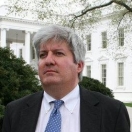
If you are reading this blog, you probably know that October 21, 2015 is unofficial “Back to the Future Day” – the day that Marty McFly traveled to the future in the movie Back to the Future Part II.
As you might suspect, we at the Office of Science and Technology Policy are pretty excited about Back to the Future Day. And in addition to its cinematic significance, today also marks the release of the President’s updated Strategy for American Innovation, which provides an overview of the Administration’s efforts to ensure that America continues to develop world-changing innovations for many years to come.
One reason for our excitement is that many of the innovations that we take for granted -- such as smart phones and global communications satellite -- were inspired by science fiction. A number of the technologies portrayed in Back to the Future are either here today (flat panel displays, video chats, gesture-based computing) or under development (flying cars, hoverboards). Many technologies and ideas that seem like science fiction today -- such as Harry Potter’s cloak of invisibility, an Iron Man suit, or Andy Weir’s story about astronauts on Mars -- are being actively explored by scientists and engineers.
This is a perfect day to start a conversation about an important topic – the role that science fiction plays in inspiring scientists, engineers, and entrepreneurs.
As science and technology continue to advance and push the boundaries of what we can achieve, the relevant question is often no longer – “What can we do?” but “What should we do?” Creativity, imagination, and storytelling can help motivate teams to work on hard problems.
There are already some initiatives to explore the boundaries between science fiction and science fact:
Academic programs like Arizona State University’s Center for Science and the Imagination bring together writers, scientists and engineers to “reignite humanity’s grand ambitions.” Arizona’s program has also encouraged science-fiction writers to portray futures in which, as author Neal Stephenson put it, “Big Stuff Gets Done.”
The National Academy of Science’s Science and Entertainment Exchange connects top entertainment-industry professionals with leading scientists and engineers, who help increase the realism of the portrayal of science in movies and TV shows.
Professors at institutions including Rollins College and the University of Minnesota, such as James Kakalios, a professor who participated in one of OSTP’s “We The Geeks” Google+ Hangouts, are teaching college classes on the physics of superheroes.
Practitioners of “design fiction” are creating artifacts such as a fictional owner’s manual for a self-driving car to spark richer conversations about the future.
We’re interested in your ideas for using science fiction as a source of inspiration, and for stimulating additional collaborations between writers, artists, scientists and engineers.
For example, America’s creative talent could help describe a future in which, as President Obama put it, we go to space “not just to visit but to stay.” I recently interviewed a former NASA physicist with a vision for bootstrapping solar system civilization. This will ultimately require developing robotic factories capable of making the full range of materials, devices and structures needed to support human civilization – using energy and raw materials from space. Compelling stories, images and movies about this scenario could motivate the next generation of science, engineers, and entrepreneurs to make it so.
If you have an idea you’d like to share with us, please drop us a line via this web form. We’d love to hear from you!


